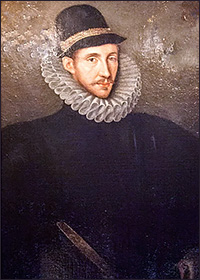|
|
|
|


Perhaps it is not easy to find in all that generation
of high-thinking and brilliantly-writing men, anyone
who combines vivid expression with weighty thought
more notably than Brooke does. |
—George Saintsbury1 |
Fulke Greville was born on Oct. 3, 1554 in Beauchamp Court, Warwickshire, to a wealthy noble family, as the only son of Sir Fulke Greville.
He entered Shrewsbury School in the same year as Sir Philip Sidney, who was to become his close friend. After leaving
Jesus College, Cambridge, he was offered a post by Sir Henry Sidney,
Philip Sidney's father, but he gave it up in order to follow Sidney to the court of Queen Elizabeth I. At court,
Greville fared well. He became part of the Areopagus
club with Spenser and Sidney, and also counted among his friends Sir Edward Dyer, Samuel Daniel
and Sir Francis Bacon.
Like many of their contemporaries—young courtiers yearning for adventure and eager to prove themselves in battle—Greville and Sidney tried
to join Sir Francis Drake in his sail to capture Spanish cities in the West
Indies in 1585. Queen Elizabeth expressly forbade Drake to take them along. In 1586, the Queen also refused Greville permission to join the
Earl of Leicester in his campaign in the Netherlands. Sidney, however, was
allowed to go; a decision all of England learned to regret, when he was killed by
a musket shot at the battle of Zutphen in October, 1586.
Greville was devastated by the loss of his childhood friend. He contributed an elegy on the death of Sidney
to The Phoenix Nest (1593) and later authored a biography in his memory. Greville finally got a taste of war in 1591, when he served
briefly in Normandy under Henry of Navarre.
Greville represented Warwickshire in Parliament for four terms, and had a distinguished career under both Queen Elizabeth I
and King James I. He was Secretary to the Principality of Wales for forty-five years,
was knighted by Elizabeth in 1597, served as Treasurer of the Navy (1589-1604), and was Chancellor of the Exchequer (1614-22). In 1621, King
James created Greville Baron Brooke, a title which had been in the family of his paternal grandmother. Greville was endowed with Knowle Park
and Warwick Castle, in the restoration of which, it is said, he spent over £20,000.
Greville was murdered by a servant, who believed he had been cheated in Greville's will, on 30 September 1628. After stabbing Greville,
the murderer, Ralph Heywood, turned the knife on himself. Greville was buried after an agonizing death at
St. Mary's Church in Warwick, where his
tomb can still be found today. Greville himself had
composed the epitaph, which reads: "Folk Grevill Servant to Queene Elizabeth Conceller to King James Frend to Sir Philip Sidney. Trophaeum Peccati."
All of his works were published posthumously, save for a few verses in anthologies, and the 1609 publishing of part of Mustapha. Greville's
works were published in folio in Certain Learned and Elegant Works
(1633). This included the sonnet cycle, Cælica, composed of love poems as well as verses on religious
and philosophical themes, and the two tragedies Alaham and Mustapha.
A third play, about Antony and Cleopatra, Greville had destroyed. In 1633 was also published A Treatie of Humane Learning,
a philosophical verse treatise on knowledge. Greville's most famous work, The Life of the Renowned Sir Philip Sidney,
probably written between 1610 and 1614, was not published until 1652.
1 In English Prose, Henry Craik, Ed. Macmillan, 1916. 425.
Bibliography:
Greville, Fulke. Poems and Dramas of Fulke Greville Geoffrey Bullough, ed. (1939)
Larson, Charles Howard. Fulke Greville (1980)
Leo, Roder, and Sierhuis, eds. Fulke Greville and the Culture of the English Renaissance (2019)
Rees, Joan. Fulke Greville, Lord Brooke, 1554-1628: A Critical Biography (1971)
Rebholz, R. A. The Life of Fulke Greville, First Lord Brooke (1971)
Waswo, Richard. The Fatal Mirror; Themes and Techniques in the Poetry of Fulke Greville (1972)
Article Citation:
Jokinen, Anniina. "Life of Fulke Greville." Luminarium.
4 Feb 2007. [Date you accessed this article].
<http://www.luminarium.org/renlit/fulkebio.htm>
 | to Fulke Greville |
Site copyright ©1996-2025 Anniina Jokinen. All Rights Reserved.
Created by Anniina Jokinen on June 12, 1996. Last updated
on March 31, 2025.
|
|
The Tudors
King Henry VII
Elizabeth of York
King Henry VIII
Queen Catherine of Aragon
Queen Anne Boleyn
Queen Jane Seymour
Queen Anne of Cleves
Queen Catherine Howard
Queen Katherine Parr
King Edward VI
Lady Jane Grey
Queen Mary I
Queen Elizabeth I
Renaissance English Writers
Bishop John Fisher
William Tyndale
Sir Thomas More
John Heywood
Thomas Sackville
John Bale
Nicholas Udall
John Skelton
Sir Thomas Wyatt
Henry Howard
Hugh Latimer
Thomas Cranmer
Roger Ascham
Sir Thomas Hoby
John Foxe
George Gascoigne
John Lyly
Thomas Nashe
Sir Philip Sidney
Edmund Spenser
Richard Hooker
Robert Southwell
Robert Greene
George Peele
Thomas Kyd
Edward de Vere
Christopher Marlowe
Anthony Munday
Sir Walter Ralegh
Thomas Hariot
Thomas Campion
Mary Sidney Herbert
Sir John Davies
Samuel Daniel
Michael Drayton
Fulke Greville
Emilia Lanyer
William Shakespeare
Persons of Interest
Visit Encyclopedia
Historical Events
Field of the Cloth of Gold, 1520
Pilgrimage of Grace, 1536
The Babington Plot, 1586
The Spanish Armada, 1588
Elizabethan Theatre
See section
English Renaissance Drama
Images of London:
London in the time of Henry VII. MS. Roy. 16 F. ii.
London, 1510, the earliest view in print
Map of England from Saxton's Descriptio Angliae, 1579
Location Map of Elizabethan London
Plan of the Bankside, Southwark, in Shakespeare's time
Detail of Norden's Map of the Bankside, 1593
Bull and Bear Baiting Rings from the Agas Map (1569-1590, pub. 1631)
Sketch of the Swan Theatre, c. 1596
Westminster in the Seventeenth Century, by Hollar
Visscher's Panoramic View of London, 1616. COLOR
|
|